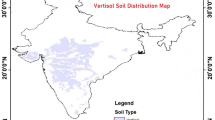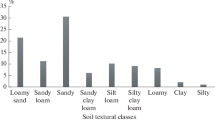Abstract
Pedotransfer functions (PTFs) are widely used for hydrological calculations based on the known basic properties of soils and sediments. The choice of predictors and the mathematical calculus are of particular importance for the accuracy of calculations. The aim of this study is to compare PTFs with the use of the nonlinear regression (NLR) and support vector machine (SVM) methods, as well as to choose predictor properties for estimating saturated hydraulic conductivity (Ks). Ks was determined in direct laboratory experiments on monoliths of agrosoddy-podzolic soil (Umbric Albeluvisol Abruptic, WRB, 2006) and calculated using PTFs based on the NLR and SVM methods. Six classes of predictor properties were tested for the calculated prognosis: Ks-1 (predictors: the sand, silt, and clay contents); Ks-2 (sand, silt, clay, and soil density); Ks-3 (sand, silt, clay, soil organic matter); Ks-4 (sand, silt, clay, soil density, organic matter); Ks-5 (clay, soil density, organic matter); and Ks-6 (sand, clay, soil density, organic matter). The efficiency of PTFs was determined by comparison with experimental values using the root mean square error (RMSE) and determination coefficient (R2). The results showed that the RMSE for SVM is smaller than the RMSE for NLR in predicting Ks for all classes of PTFs. The SVM method has advantages over the NLR method in terms of simplicity and range of application for predicting Ks using PTFs.
Similar content being viewed by others

References
Bouma, J., Using soil survey data for quantitative land evaluation, Adv. Soil Sci., 1989, vol. 9, pp. 177–213.
Kecman, V., Learning and Soft Computing, Support Vector Machines, Neural Networks, and Fuzzy Logic Models, Cambridge, MA, 2001.
Klute, A. and Dirksen, C., Hydraulic conductivity of saturated soils, in Methods of Soil Analysis, Klute, A., Ed., Madison, WI, 1986.
Lamorski, K., Pachepsky, Y., Slawinski, C., and Walczak, R.T., Using support vector machines to develop pedotransfer functions for water retention of soils in Poland, Soil Sci. Soc. Am. J., 2008, vol. 72, no. 5, pp. 1443–1452.
Lamorski, K., Slawinski, C., Moreno, F., et al., Modelling soil water retention using support vector machines with genetic algorithm optimisation, Sci. World J., 2014, id 740521. doi 10.1155/2014/740521
Mady, A.Y. and Shein, E.V., Modeling soil thermal diffusivity as a function of soil moisture, Bull. Orenburg State Univ., 2016, vol. 12, no. 200, pp. 56–60.
Parsaie, A. and Haghiabi, A.H., Improving modelling of discharge coefficient of triangular labyrinth lateral weilrs using SVM, GMDH and MARS techniques, Irrig. Drain, 2017 vol. 66, no. 4, pp. 636–654. doi 10.1002/ird.2125
Schaap, M.G., Leij, F.J., and van Genuchten, M.T., ROSETTA: a computer program for estimating soil hydraulic parameters with hierarchical pedotransfer functions, J. Hydrol., 2001, vol. 251, no. 3–4, pp. 163–176.
Shein, E.V., Mady, A.Y., and Mohamed El Hassna A., Soil saturated hydraulic conductivity assessment by direct and pedotransfer functions methods, Biogeosyst. Techn. J., 2015, vol. 6, no. 4, pp. 396–400.
Twarakavi, N.K.C., Šimunek, J., and Schaap, M.G., Development of pedotransfer functions for estimation of soil hydraulic parameters using support vector machines, Soil Sci. Soc. Am. J., 2009, vol. 73, no. 5, pp. 1443–1452.
Walczak, R.T., Moreno, F., Salwinski, C., et al., Modeling of soil water retention curve using soil solid phase parameters, J. Hydrol., 2006, vol. 329, nos. 3–4, pp. 527–533.
Wohlberg, B., Tartakovsky, D.M., and Guadagnini, A., Subsurface characterization with support vector machines, IEEE Trans. Geosci. Rem. Sens., 2006, vol. 44, no. 1, pp. 47–57.
Wösten, J.H.M., Finke, P.A., and Jansen, M.J.W., Comparison of class and continuous pedotransfer functions to generate soil hydraulic characteristics, Geoderma, 1995, vol. 66, nos. 3–4, pp. 227–237.
Wösten, J.H., Lilly, A., Neme, A., et al., Development and use of a database of hydraulic properties of European soils, Geoderma, 1999, vol. 90, nos. 3–4, pp. 169–185.
Author information
Authors and Affiliations
Corresponding author
Additional information
Original Russian Text © A.Y. Mady, E.V. Shein, 2018, published in Vestnik Moskovskogo Universiteta, Seriya 17: Pochvovedenie, 2018, No. 3, pp. 42–47.
About this article
Cite this article
Mady, A.Y., Shein, E.V. Support Vector Machine and Nonlinear Regression Methods for Estimating Saturated Hydraulic Conductivity. Moscow Univ. Soil Sci. Bull. 73, 129–133 (2018). https://doi.org/10.3103/S0147687418030079
Received:
Published:
Issue Date:
DOI: https://doi.org/10.3103/S0147687418030079



